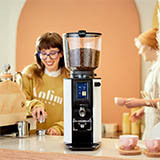
Google Reviews
The Ultimate Guide to Buying a Commercial Coffee Grinder
If the espresso machine is the engine of your café, the grinder is the transmission. It’s impossible to pull a great shot of espresso without a high-quality, consistent grind. A commercial coffee grinder is designed to withstand the demands of a busy service, providing uniform particles shot after shot, day after day. This guide will break down the essential technology and features to help you select the perfect commercial espresso grinder for your business's needs.
Step 1: On-Demand Hopper Grinder vs. Single Doser
First, decide on your primary workflow. This choice impacts speed, waste, and the type of coffee program you can run.
- On-Demand Hopper Grinders: This is the standard for 99% of cafés. A large hopper holds a bag of beans, and the barista grinds a fresh dose directly into the portafilter for each shot. It is optimized for speed and efficiency, making it essential for handling a morning rush.
- Single Dose Grinders: This style is built for precision and variety. The barista weighs a specific dose of beans for each individual shot and grinds it through the machine, which is designed to have near-zero retention (no old grounds left behind). This is ideal for offering a rotating menu of special single-origin espressos or for a coffee lab environment, but it is much slower for a primary espresso workflow.
Step 2: Burr Type & Size - The Heart of Your Grinder
The burrs do the actual work of grinding, and their design dramatically affects the taste in the cup and the grinder's performance.
- Flat Burrs: Known for producing a highly uniform and consistent particle size. This often results in espresso with a heavy, syrupy body and rich, chocolatey, and nutty flavors. Flat burrs are fantastic for classic espresso blends and promoting a uniform extraction.
- Conical Burrs: These burrs produce a bimodal distribution of particles (a mix of very fine and slightly larger particles). This can result in espresso with enhanced flavor clarity, highlighting bright, fruity, and floral notes. They also tend to grind faster and at lower RPMs, generating less heat.
- Burr Size: Size matters. Larger burrs (e.g., 83mm vs. 64mm) have more cutting surface area, allowing them to grind the same amount of coffee faster and with less heat buildup. For a medium-to-high volume café, larger burrs are a significant advantage for both speed and quality.
Step 3: Dosing Methods - Consistency is Key
How the grinder measures out each dose is critical for a consistent recipe and efficient workflow.
- Timed Dosing (Doserless): The most common method. You program the grinder to run for a specific amount of time (e.g., 3.5 seconds) to dispense the target dose. It's fast and effective, but may require slight adjustments throughout the day as the bean density changes.
- Grind-By-Weight (GBW): The new gold standard for accuracy. These grinders have a built-in scale and dose coffee to a precise weight (e.g., 18.0 grams) every time. This eliminates the need for constant adjustments, reduces coffee waste, and guarantees absolute consistency between baristas.
Step 4: Features That Define Workflow & Quality
Look for these features that separate good grinders from great ones.
- Stepless Adjustment: Allows for infinite, tiny adjustments to the grind size, giving you the precision needed to perfectly "dial in" your espresso.
- Cooling System: In a busy café, burrs heat up, which can alter the grind size and negatively affect flavor. Grinders with built-in cooling fans maintain thermal stability, ensuring your first shot of the day tastes the same as your hundredth.
- Low RPM Motor: A motor that spins the burrs more slowly generates less heat and operates more quietly, which helps preserve the delicate aromatic compounds in the coffee.
Explore Our Top Grinder Brands
We partner with the most respected brands in the industry, each known for building reliable and innovative commercial coffee grinders. Find the one that's right for you.
Mazzer | Mahlkönig | Anfim | Ditting | Hey Cafe | Ditting | Mythos (Nuova Simonelli)
Frequently Asked Questions
What is the best commercial coffee grinder?
The "best" grinder depends entirely on your café's volume and coffee program. For most specialty cafés, a 2-group espresso machine is best paired with a workhorse on-demand grinder like a Mazzer Super Jolly or Major. High-volume shops often choose faster grinders like the Mahlkönig E80 or Mythos. The key is to match the grinder's capabilities to your busiest hour.
How often do I need to replace the burrs on a commercial grinder?
Burrs are a consumable part and need to be replaced to maintain grind quality. The lifespan depends on the burr size and material, but a general rule of thumb is to replace standard steel burrs after grinding 800-1,500 lbs of coffee. Worn-out burrs will produce an inconsistent grind and make it difficult to dial in your espresso.
Can I use one grinder for both regular and decaf espresso?
While technically possible, it is highly inefficient and not recommended for a commercial workflow. Switching between coffees requires recalibrating the grind setting, which wastes time and coffee. Nearly all cafés use a primary grinder for their main espresso and a second, often smaller, grinder dedicated solely to decaf.





